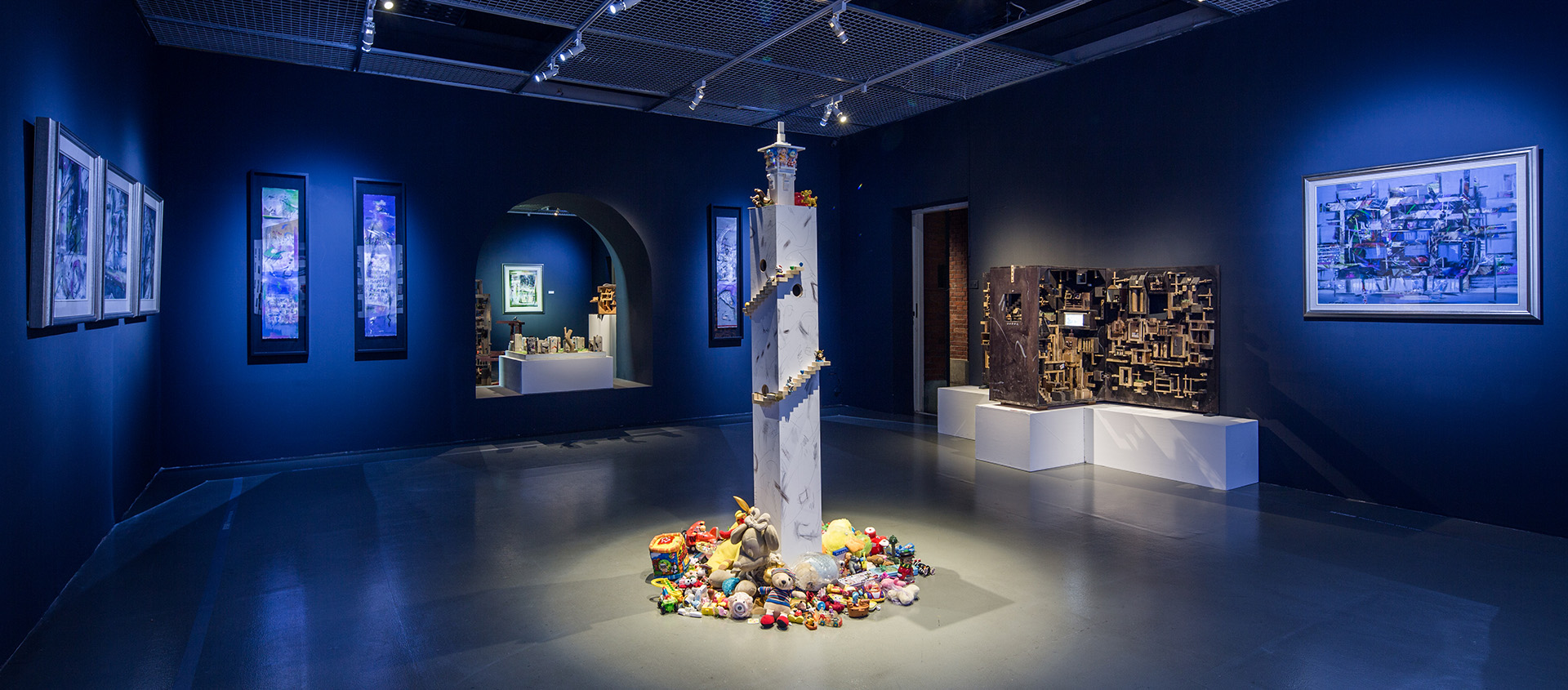

台北當代藝術館 官方網站 Museum of Contemporary Art, Taipei
Sunday 星期日
10AM - 6PM



Sunday 星期日
10AM - 6PM
EXHIBITIONS & EVENTS 展覽活動

2014 / 02 / 15 Sat.
2014 / 03 / 23 Sun.
10:00 - 18:00
地點
Venue
MoCA Studio
「富而謀殺」一詞呼喚的是美麗寶島福爾摩沙,反映的卻是在富裕的物質生活及社會表象下,居民的內在精神和原有的自然環境,卻都被謀害了!貪婪的物慾抹煞了福爾摩沙的原相之美和純樸人性。藝術家引用「黑天鵝效應」 的典故,貼切描繪近年台灣社會中,許多看似極不可能的事件,卻實際發生了:從都更議題、食品安全、土地徵收到國土保育等問題,一再出現的衝突與抗爭,皆肇因於現代人無盡慾望所架構出的物質導向社會,而心/物嚴重的不平衡,已點點滴滴蝕耗了寶島台灣的人、事、物。 本展第一展室主要在鋪陳黃銘祝對於家鄉土地的關懷及人類造成環境破壞的反思。位於入口的作品〈回家吧!回到原初的美好〉,以客家花布及舊木料,拼貼出對於原鄉美好的想像。【回到原點】系列裝置結合錄像作品〈當幸福與你捉迷藏〉建構出了這個展場的問題意識與空間氛圍。另一件折盒式的箱形裝置〈失樂園〉,以迷宮劇場的概念,娓娓呈現了生態物種滅絕,自然反撲下的一種「後災難時代」意象。而放置於拱門空間中的〈下一步棋〉,也畫龍點睛地傳達了現代社會與自然環境之間的僵局,正是一種「無法前進也無法後退」的曖昧與尷尬!走道空間的兩端,裝置作品〈無憾的連結〉與錄像作品〈眸界〉相互呼應地呈現,前者以回收木材拼貼台灣都市街景,後者以類平面拼貼作品製成如真似幻的3D動畫,表現人類文明物慾無盡衍異,終至吞噬自我生存空間的奇幻景像。 相對於第一展間呈現對大環境的省思,第二展間著重於藝術家個人對心靈生活及內在精神的觀照。除了四組個人日記式的平面畫作,另二件裝置作品〈潘朵拉的盒子〉與〈記憶裂痕〉,明顯反映出現代社會及人心充滿困惑、焦慮的失衡狀態和無法捉摸的空虛感;其中一件現成物裝置〈巴別塔〉,則是開放民眾參與互動,具有社會普查意義的一件作品,此作邀請觀眾將家中淘汰的玩具帶到展場進行交換,巴別塔本身指涉了人類慾望的構築和無止境的堆疊,也關連到人類文明透過慾望交流和語言溝通而得以發展的史實。以物易物的人際互動和資源交換方式,是人類最初的文明儀式之一,可能也是導正當代消費文化帶來之環保危機的一帖良方。黃銘祝希望透過本次在當代館實驗展場的個展,傳達人類必須參透文明帶來的危機和永續生存的課題,在自我與自然之間取得平衡點,撥亂反正,回歸原初的美好! 十八世紀的歐洲人曾相信天鵝只有白色的,直到在澳洲發現黑天鵝,才發現自己的無知,被後人稱為「黑天鵝效應」。 “Formosa erased” evokes the reality that the once beautiful, natural island of Taiwan as well as its inhabitants’ inner spirit is now suffocated by the materialism of the society. The greed for material development has veiled the original iridescence of land and benevolent human nature. The artist employs the “Black Swan Theory” to describe the fact that many seemingly impossible events have taken place in Taiwan recently; from the controversy of urban renewal, to the problem of food safety, to the commandeering of private lands, to the conservation of natural environment, these constant conflicts and arguments all arise from the material-oriented society kidnapped by people’s incessant desires. As a result, the imbalance between the spiritual and the material has gradually eroded the inhabitants and the land of Taiwan. The first gallery of Formosa Erased reveals Huang’s concerns for his homeland and his contemplation on the environmental catastrophe caused by mankind. At the entrance of the gallery situates Come Back Home! To the Wonderful Beginning, which uses pieces of fabric with traditional Hakka patterns and recycled wood to create a pastiche of an ideal home/land. Installations in Back to the Start series are combined with a video work, Play Hide and Seek with Happiness—a site-specific spatial installation used by the artist to raise his question regarding the environment. Paradise Lost, an installation in box form employs theatrical, labyrinthian elements to delineate the verging crisis of species distinction. All artworks serve to present an image of the “post-catastrophe era” when Mother Nature starts her retaliation. Next Move is placed under the arch, connecting the two galleries, and subtly exposes the impasse between economic development and natural environment—an ambiguous and embarrassing situation that allows no elbow room. On the two opposites of the hallway exhibit installation series titled The Never-ending Extension and video work Vision Possessed. The former is a series of cityscapes made with recycled wood while the latter is a 3D animation based on the aforementioned cityscapes, demonstrating the destruction brought forth by materialistic desires of human civilization. The second gallery focuses more on Huang’s introspection of the spiritual aspect in life. In addition to the four series of paintings that record his daily observation and contemplation, Pandora’s Box and Fragment of Memory both serve as metaphors for the confused, anxious, empty modern society and minds. Tower of Babel, an installation made with ready-made objects, is an interactive piece that invites audience’s participation and functions as a social investigation; audience can actually exchange their unwanted toys with the dolls in the installation. The Tower of Babel in the original story is a symbol of human’s ego; it is also about the interaction of different human races and linguistic communication. Exchange of resources and the social interaction it entails could be found at the dawn of human civilization, and could just as well be a way to curve materialism that has caused our ecological crisis. Huang wishes to convey the idea that the entire human race must understand what our civilization has done to the world, strive for sustainable development, find the balance between its ego and nature, set the record straight, and finally return to the wonderful beginning! “The Black Swan Theory” refers to the fact that the 18th century Europeans once believed that there were only white swans until black swans were found in Australia, a turn of event that made them realize their own ignorance.
MORE
LESS
黃銘祝1956年生於台南,畢業於國立臺灣師範大學美術系西畫組。曾任國立新竹教育大學藝術與設計學系專任教授、系主任等職,現為私立長榮大學美術系專任教授兼系主任。黃銘祝的早期創作以鄉土寫實風的水彩畫著稱,被視為台灣鄉土寫實主義的重要代表人物,近期創作跨及複合媒材及影像新媒體之運用,內容意識也從早年的懷舊美感轉為當下社會情境的觀想與批判。
2013 【102年全國美展】,國立臺灣美術館,台中,台灣
2013 【黃銘祝個展】,清大藝術中心,新竹,台灣
2012 【馬來西亞文化交流展】,吉隆坡創價學會綜合展示中心,吉隆坡,馬來西亞
2012 【北京文化交流展】,北京臺聯臺灣會館
2011 【 TWO POINTS Taiwan + China contemporary】,Villa Benzi Zecchini,聖馬可的城卡爾蘭諾,義大利
2009 【台灣水彩經典大展】,國立台灣民主紀念堂,台北,台灣
Ming-chu Huang was born in Taiwan in 1956, and graduated from the Department of Fine Arts (Western Painting) of National Taiwan Normal University. He was the head and professor of the Department of Arts and Design, National Hsinchu University of Education, and is the head and professor of the Department of Fine Arts, Chang Jung Christian University. Huang was well-known for his earlier regional realistic watercolors, and was deemed one of the representative figures of Taiwanese regional realism. He uses mixed media and new media in his recent works and focuses more on social criticism and contemplation instead of the nostalgic aesthetics foregrounded in his earlier works.
2013 ROC National Art Exhibition, National Taiwan Museum of Fine Arts, Taichung, Taiwan.
2013 Ming-chu Huang Solo Exhibition, National Tsing Hua University Arts Center, Hsinchu, Taiwan.
2012 Malaysian Cultural Exchange Exhibition, SGI Kuala Lumpur, Kuala Lumpur, Malaysia.
2012 Beijing Cultural Exchange Exhibition, Taiwan Assembly Hall, Beijing, China
2011 TWO POINTS Taiwan + China Contemporary, Villa Benzi Zecchini, Caerano di San Marco Treviso, Italy.
CLOSE
CLOSE
著作權聲明
台北當代藝術館尊重他人著作權,台北當代藝術館服務條款亦明定,網友使用台北當代藝術館服務不得侵害他人之著作權,因此,台北當代藝術館呼籲使用者同樣尊重他人之著作權。如果您認為台北當代藝術館網站中之任何網頁內容或網友使用台北當代藝術館服務已侵害您的著作權,建議您利用本處理辦法提出檢舉,台北當代藝術館客服中心將儘速為您處理:
若台北當代藝術館網站中之任何網頁內容或網友使用台北當代藝術館服務已侵害您的著作權,請您填寫:「 著作權侵權通知書」,且依該通知書所載提供下列資料及聲明,並以傳真的方式通知台北當代藝術館:
1、著作權人之簽名、或著作權人之代理人之簽名、相關權利證明文件及著作權之內容,例如:已發行書籍之封面及相關頁面、發表於網路中之網頁內容列印紙本及其網址。
2、侵害著作權之內容所在的網頁及網址。
3、您的聯絡地址、電話等資料。
4、書面聲明您確信該網頁內容的使用行為是未經過著作權人、其代理人或法律的授權。
5、書面聲明您於通知書所載相關資料均為真實,且您是著作權人或著作權人之代理人而為上開聲明。
若台北當代藝術館網站中之任何網頁內容或網友使用台北當代藝術館服務已侵害您的著作權,請您填寫:「 著作權侵權通知書」,且依該通知書所載提供下列資料及聲明,並以傳真的方式通知台北當代藝術館:
1、著作權人之簽名、或著作權人之代理人之簽名、相關權利證明文件及著作權之內容,例如:已發行書籍之封面及相關頁面、發表於網路中之網頁內容列印紙本及其網址。
2、侵害著作權之內容所在的網頁及網址。
3、您的聯絡地址、電話等資料。
4、書面聲明您確信該網頁內容的使用行為是未經過著作權人、其代理人或法律的授權。
5、書面聲明您於通知書所載相關資料均為真實,且您是著作權人或著作權人之代理人而為上開聲明。
隱私權保護政策
台北當代藝術館非常重視用戶的隱私權,因此制訂了隱私權保護政策。請你細讀以下有關隱私權保護政策的內容。
隱私權保護政策的適用範圍
1、隱私權保護政策內容,包括台北當代藝術館如何處理在用戶使用網站服務時收集到的身份識別資料,也包括台北當代藝術館如何處理在商業伙伴與台北當代藝術館合作時分享的任何身份識別資料。
2、隱私權保護政策不適用於台北當代藝術館以外的公司,也不適用於非台北當代藝術館所僱用或管理的人員。
3、台北當代藝術館在你註冊台北當代藝術館帳號、使用台北當代藝術館的產品或服務、瀏覽台北當代藝術館網頁、參加宣傳活動或贈獎遊戲時,台北當代藝術館會收集你的個人識別資料。台北當代藝術館也可以從商業夥伴處取得個人資料。
4、當你在台北當代藝術館註冊時,我們會問及你的姓名、電子郵件地址、出生日期、性別、職位、行業及個人興趣等資料。你在台北當代藝術館註冊成功,並登入使用我們的服務後,我們就會認識你。
5、台北當代藝術館也自動接收並紀錄你瀏覽器上的伺服器數值,包括互聯網協定位址 (IP Address) 、台北當代藝術館cookie中的資料及你要求取用的網頁紀錄。
6、台北當代藝術館會使用資料作以下用途:改進為你提供的廣告及網頁內容、完成你對某項產品的要求及通知你特別活動或新產品。
7、台北當代藝術館不會向任何人出售或出借你的個人識別資料。
8、在以下的情況下,台北當代藝術館會向政府機關、其他人士或公司提供你的個人識別資料:與其他人士或公司共用資料前取得你的同意。
9、需要與其他人士或公司共用你的資料,才能夠提供你要求的產品或服務。
10、向代表台北當代藝術館提供服務或產品的公司提供資料,以便向你提供產品或服務 (若我們沒有事先通知你,這些公司均無權使用我們提供的個人資料,作提供產品或服務以外的其他用途)。
11、應遵守法令或政府機關的要求。
12、我們發覺你在網站上的行為違反 台北當代藝術館服務條款或產品、服務的特定使用指南。
13、其他依「個人資料保護法」或政府法令應公開之資料。
14、為了保護使用者個人隱私, 我們無法為您查詢其他使用者的帳號資料,請您見諒!若您有相關法律上問題需查閱他人資料時,請務必向警政單位提出告訴,我們將全力配合警政單位調查並提供所有相關資料,以協助調查及破案!
15、 台北當代藝術館會到你的電腦設定並取用台北當代藝術館cookie。
16、台北當代藝術館容許在我們網頁上擺放廣告的廠商到你的電腦設定並取用cookie。其他公司將根據其自訂的隱私權保護政策,而並非本政策使用其cookie。其他廣告商或公司不能提取台北當代藝術館的cookie。
17、當台北當代藝術館進行與其產品及服務有關的工作時,會使用 web beacons 進入我們的網站網絡,提取cookie使用。
18、台北當代藝術館賦予你在任何時候修改個人台北當代藝術館帳號資料及偏好設定的權力,包括接受台北當代藝術館通知你特別活動或新產品的決定權。